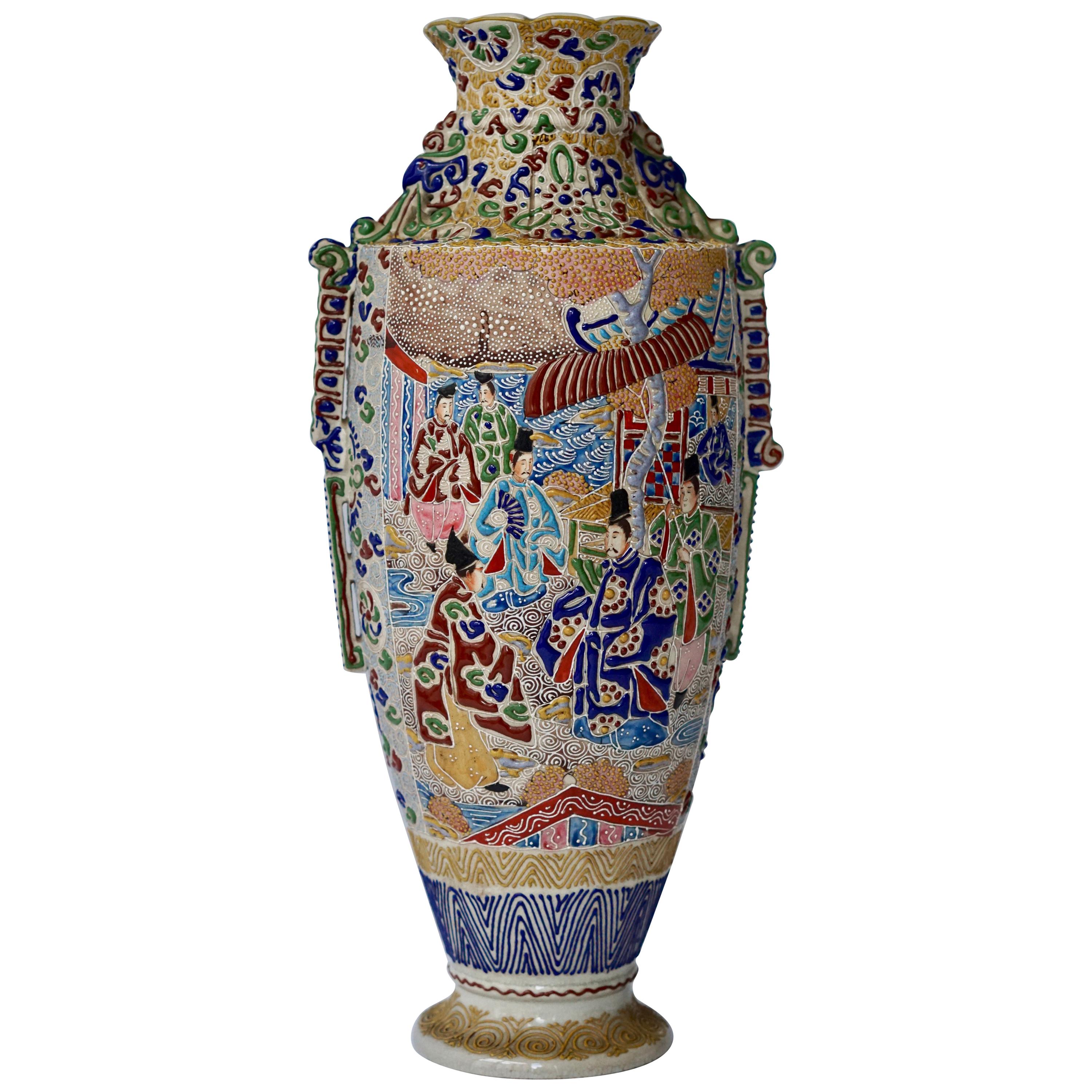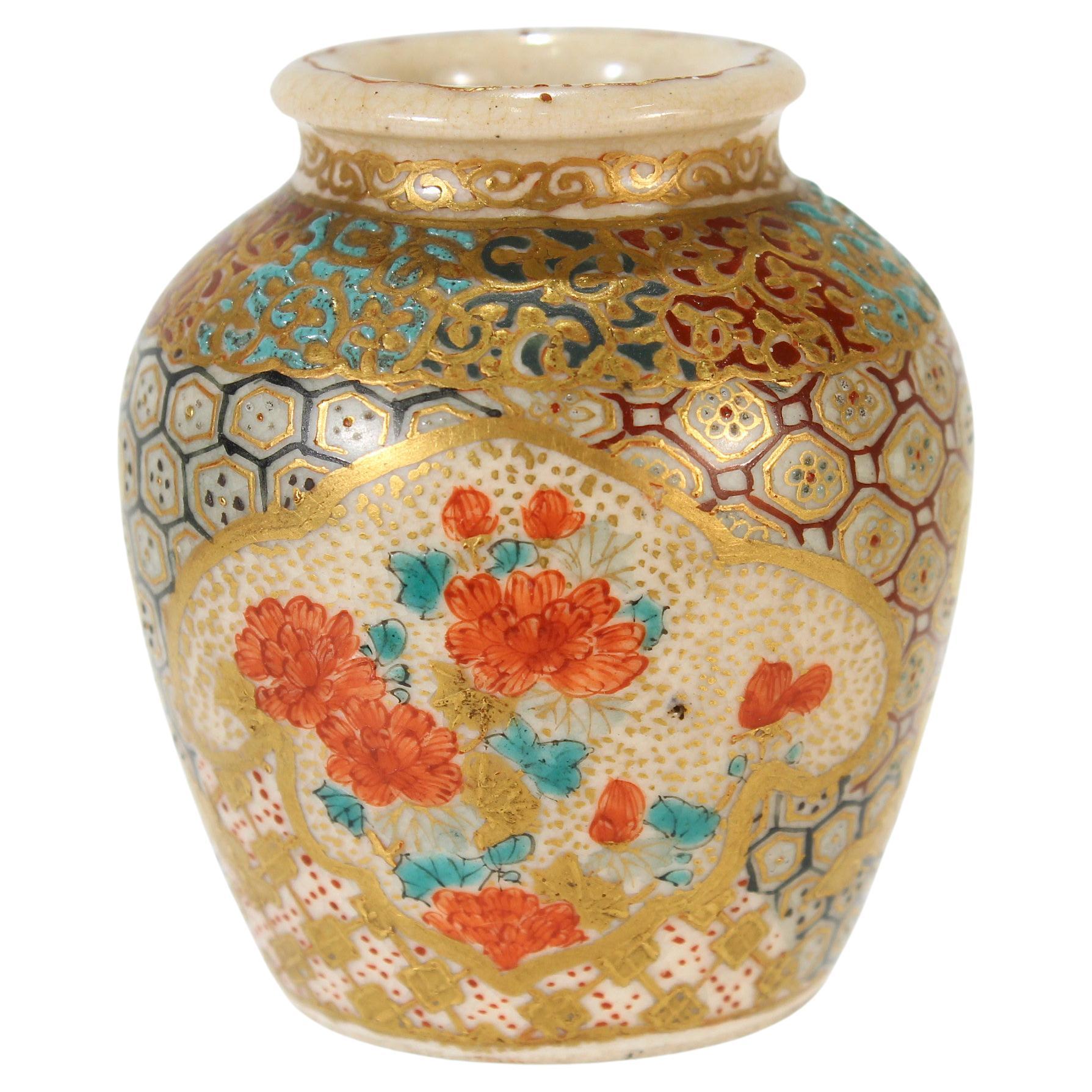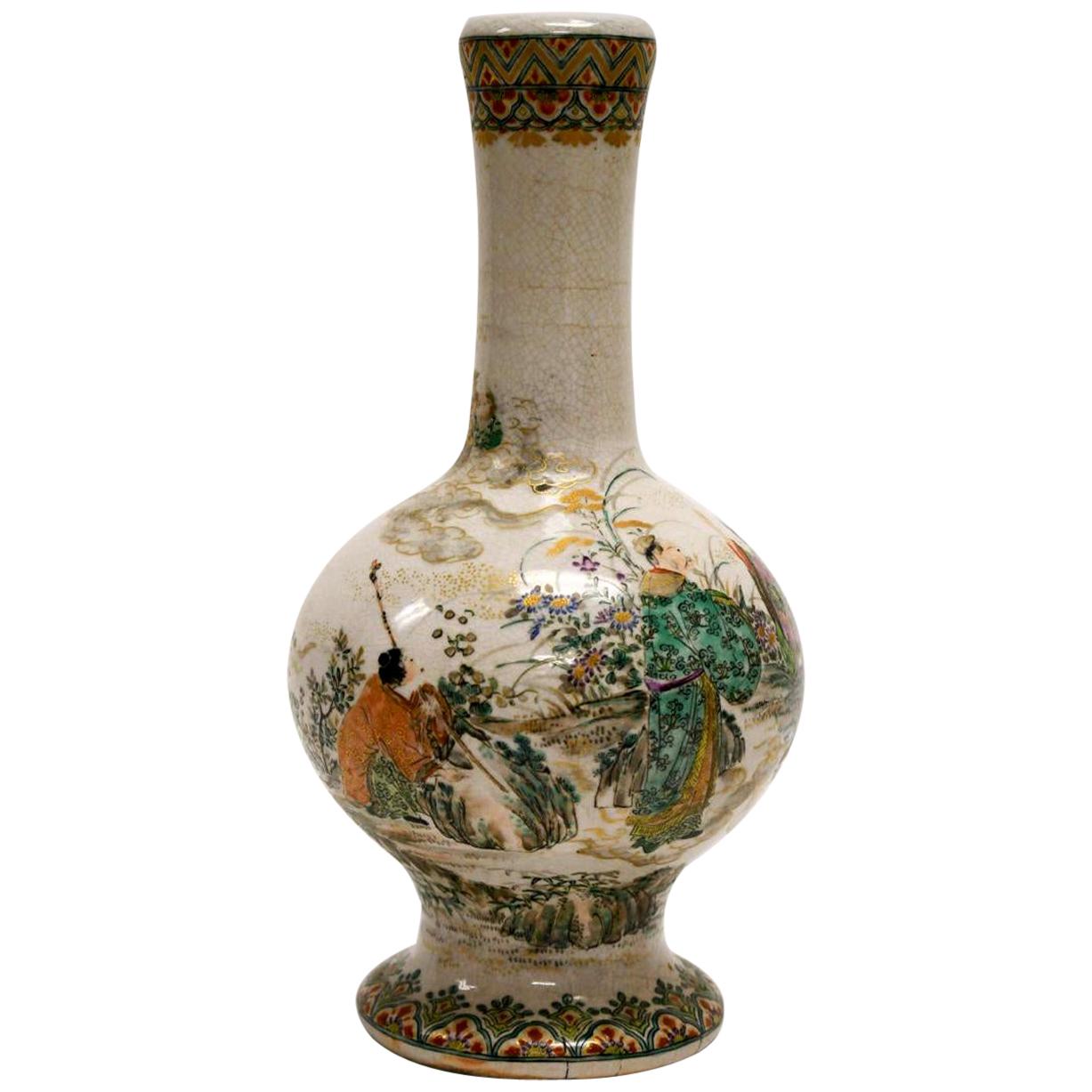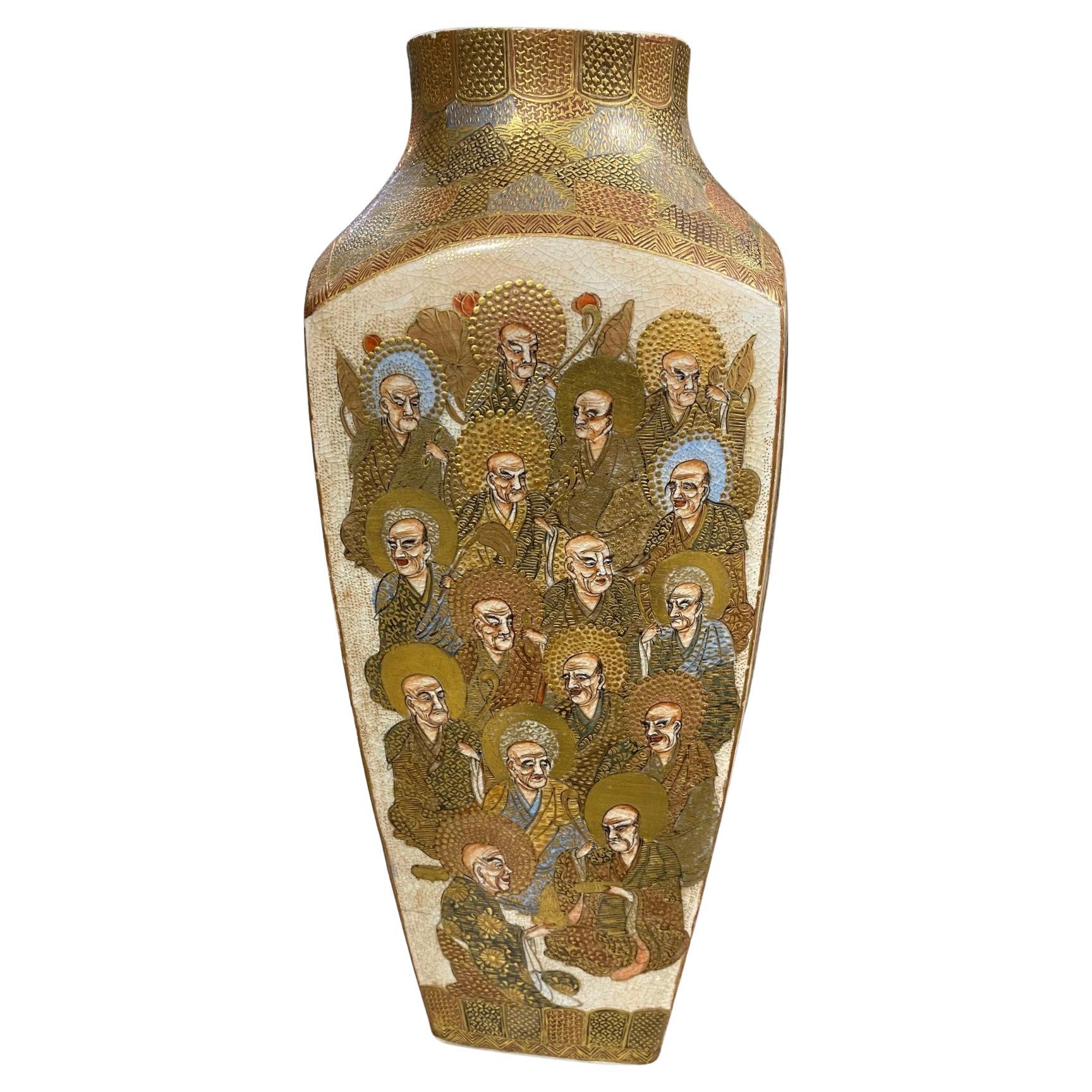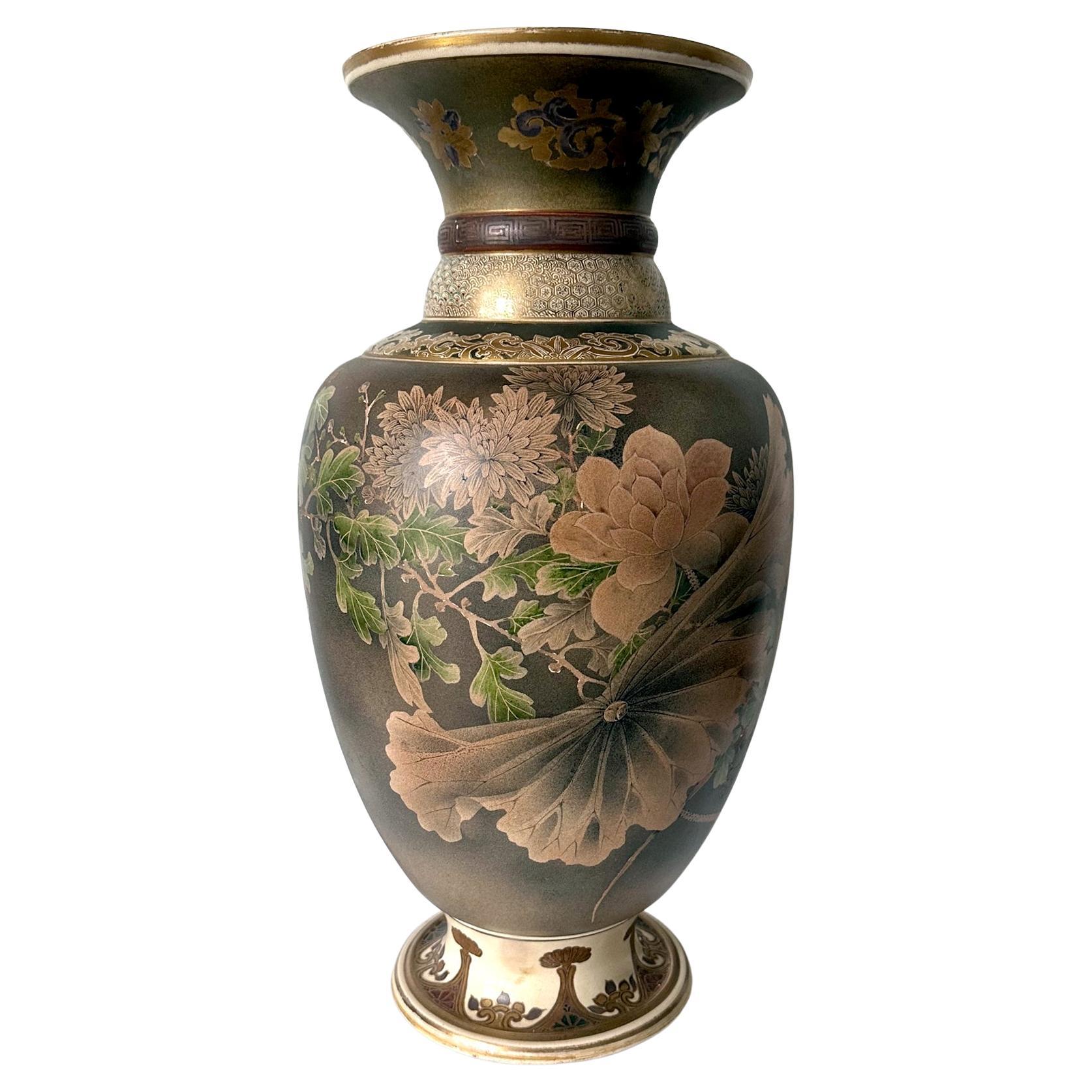Items Similar to Rare Antique Japanese Satsuma Vase with Scenes of Figures, Turtle Basin, Reading
Want more images or videos?
Request additional images or videos from the seller
1 of 12
Rare Antique Japanese Satsuma Vase with Scenes of Figures, Turtle Basin, Reading
About the Item
Rare Meiji Period Japanese satsuma vase with superbly painted scenes of a sage and his young companion observing three golden turtles swimming in a large basin on one side, with a reclining sage reading a book next to a young boy reading on the other side. The turtle is a well known symbol of wisdom, longevity and good luck in Japanese culture. Reading and education are highly revered for the transformative expansion they offer the individual and society.
This beautiful vase incorporates several techniques of painting: the wide gold border at the top of the foot showcases the fine gold on gold decoration, the main body of the vase is in the traditional polychrome style highlighted with raised gold accents and the top of the vase is profusely decorated with classical Japanese patterns with raised polychrome highlights.
Exceptionally fine detail and condition.
- Dimensions:Height: 10.25 in (26.04 cm)Diameter: 5.5 in (13.97 cm)
- Style:Meiji (Of the Period)
- Materials and Techniques:
- Place of Origin:
- Period:
- Date of Manufacture:19th Century
- Condition:Wear consistent with age and use.
- Seller Location:New York, NY
- Reference Number:1stDibs: LU5828227334902
About the Seller
5.0
Gold Seller
These expertly vetted sellers are highly rated and consistently exceed customer expectations.
1stDibs seller since 2021
32 sales on 1stDibs
Typical response time: 1 hour
- ShippingRetrieving quote...Ships From: New York, NY
- Return PolicyA return for this item may be initiated within 3 days of delivery.
More From This SellerView All
- Antique French Provincial Armorial Snake Handled Faience Bough Pot VaseBy DesvresLocated in New York, NYFabulous antique French Provincial faience Armorial snake handled bough pot vase with three Armorial shields depicting a Fleur-de-Lis, a Cross and a V shaped emblem topped by a large...Category
Antique 19th Century French French Provincial Delft and Faience
MaterialsCeramic, Faience
- Rare Japanese Meiji Gold Silver Inlay Peacock Bronze Usubata Ikebana Flower VaseLocated in New York, NYRare peacocks and peonies antique Japanese Meiji period patinated bronze gold and silver inlaid signed Usubata vase for Ikebana, the Japanese art of flower arrangement Late 19th Cent...Category
Antique Late 19th Century Japanese Meiji Metalwork
MaterialsGold, Silver, Bronze
- Japanese Meiji Period Antique Lacquer Box with Gold Maki-e DecorationLocated in New York, NYA fine antique Japanese Meji Period lacquer box decorated with a fan and a stylized star shaped window in the maki-e technique. The fan at the top right corner, fully opened depictin...Category
Antique 19th Century Japanese Meiji Lacquer
MaterialsLacquer
- Large Estate Signed Baccarat Empire Harcourt Bronze and Crystal VaseBy BaccaratLocated in New York, NYImpressive signed Baccarat Empire style bronze and crystal vase. Beautifully complements the Classic 1841 Harcourt and Empire patterns, similar to the ...Category
20th Century French Empire Vases
MaterialsCrystal, Bronze
- Antique Japanese Meiji Bronze Lobster, Seashell, Basketweave, Bamboo PlanterLocated in New York, NYUnusual rhombus shaped Japanese Meiji period bronze sea-life motif bonsai, bamboo planter, ikebana. The body in the form of a densely woven basket of fine detail, with a large lobster, clam shell, cockle, conch, crab, pearl oyster and whelk sculptural motifs on the sides, set upon bamboo form bronze feet. The base signed in Japanese within an ornate seal. Perfectly sized for an artistic bonzai tree...Category
Early 20th Century Japanese Meiji Metalwork
MaterialsBronze
- Japanese Genryusai Seiya Meiji Period Antique Patinated Bronze GeishaLocated in New York, NYJapanese Meiji period patinated bronze sculpture of a geisha waiving her hand in greeting signed Genryusai Seiya 19th Century The attractive young geisha is dressed in traditional Ja...Category
Antique 19th Century Japanese Meiji Figurative Sculptures
MaterialsBronze
You May Also Like
- Japanese Satsuma Vase with FiguresLocated in Antwerp, BEA mid-20th century Japanese Satsuma vase with figures. Satsuma ware is a style of Japanese earthenware originally from the Satsuma region of what is today southern Kyushu. There are two distinct categories of this ware: The original plain dark clay early Satsuma...Category
Mid-20th Century Japanese Japonisme Vases
MaterialsCeramic
- Antique Japanese Satsuma Miniature Cabinet VaseBy Master RyozanLocated in Philadelphia, PAA fine diminutive, antique Japanese Satsuma pottery cabinet vase. Decorated throughout with gilding and raised enamel. There are...Category
20th Century Japanese Meiji Vases
MaterialsCeramic
- Japanese Satsuma Vases, PairBy SatsumaLocated in New York, NYA gorgeous pair of Japanese earthenware Satsuma vases, hand-painted, Meiji period, circa early-20th century, Japan. Vases' beautiful decoration is high-qu...Category
Early 20th Century Japanese Meiji Ceramics
MaterialsEarthenware
- Early Japanese Satsuma Antique VaseBy SatsumaLocated in Atlanta, GAAn Satsuma ceramic stone ware vase, circa 19th century, around the end of the Edo and the beginning of Meiji period. In the form of a Classic garlic bottle whose prototype was from China, the white bodied piece is decorated with an early form of kin nishikide, the so called golden brocade, a palette of iron-red, blue, green, yellow, purple and black with golden highlight. The over glazed enamel paint shows a group of robed figures in a garden setting with a lion and three tigers. A transparent overall glaze shows very fine crackles. The design is relatively sparse with plenty of negative space in contrast to the Satsuma production from the late 19th century, when the trend became fussy and overly glitz, due to the influence by the perceived western taste for the export market. This piece may still be made for export but its pattern was more influenced by both Kyoto Pottery and the Kano school of painting compared to the export ware by the end of the 19th century onward to the early 20th century. It was believed by many that this was a result of Satsuma potters visiting Kyoto in the late seventeenth century to learn over glaze painting techniques. There are some age glaze crackles especially around the foot. The piece is not signed in keeping with the earlier production before Satsuma ceramics...Category
Antique Mid-19th Century Japanese Japonisme Ceramics
MaterialsCeramic
- Japanese Antique Satsuma Pottery Buddhist Monks Vase with Shimazu Crest MarkBy SatsumaLocated in Studio City, CAA beautiful Japanese Satsuma pottery studio vase featuring multiple kesa-clad enlightened Buddhist monks on each side of the vase. The piece is finely detailed with rich raised gilt highlights throughout and beautifully decorated in gold and various hand painted other colors. From the Meiji period (1868-1912). This piece has the all-important Shimazu Family crest mark (red circle with a cross inside) on the base authenticating the work as an old and original Satsumaware work. The mark shows the pottery was made under the rule of the Shimazu clan. From a Los Angeles Collection...Category
Early 20th Century Japanese Meiji Ceramics
MaterialsEarthenware, Pottery
- Large Japanese Satsuma Ceramic Vase KinkozanBy KinkozanLocated in Atlanta, GAA large Japanese ceramic vase from the end of Meiji period circa 1890-1910s by Kinkozan (1645-1927). One of the largest studio manufacturers of the export ceramics at the time based in Kyoto. In the typical style of satsuma made at the turn of 20th century, the vase is elaborately decorated with a rather unusual kinran-de (gold paint) and green enamel highlight on a mottled brown background. The painterly decoration depicts a large seasonal floral arrangement in a circular fashion. Besides the obviously superb craftsmanship, what sets this particular vase apart from many lower quality and mass-produced pieces is its tone-on-tone color pallet that is visually somber and the small and sensitive details that heralds the change of the seasons. When the viewer goes beyond the first casual glimpse of the blossom and foliage, one would notice that on the edges of certain leaves as well as along the stalks, there accumulates a very thin layer of the white dust that represents the frost. The flower in bloom are chrysanthemums. Despite of being splendid, they are the messengers of the autumn. The large lotus leaf was subtly rendered in a bended and slightly withered manner, just past its prime. Although the lotus is still in bloom, the prominent seed pod indicates it may be the last for the season. The sentimental capture of the change of the seasons is not unusual in Japanese art. This vase poetically represents such a subtle transition from summer to fall, perhaps depicting the very first frost. The neck of the vase is also slightly unusual with two rolled rings...Category
Early 20th Century Japanese Meiji Ceramics
MaterialsCeramic
Recently Viewed
View AllMore Ways To Browse
Japanese Pattern
Japanese Rare
Japanes Rare
Antique Furniture Reading
Gold Reading
Hand Basin
Japan Book
Antique Hand Basin
Basin Japan
Antique Japanese Figures
Japanese Antique Figures
Ceramic Japanese Style
Polychrome Figures
Japanese Satsuma
Japanese Antiques Ceramic
Antique Turtle
Classical Japanese Furniture
Antique Japanese Satsuma
